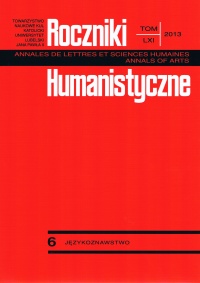A Discussion of Some Possible Stages in the Evolution of Syntax
Abstract
This paper provides an overview of some possible stages in the evolution of syntax. It is argued, following Heine & Kuteva (2007), Jackendoff (1999), Johansson (2005), and Burling (2002), that syntax developed gradually through clearly identifiable developmental stages, not as maintained by Bickerton (1990) in one fell swoop.
References
Bickerton D.: Language and species, Chicago and London 1990.
Bickerton D.: Language evolution: a brief guide for linguists, „Lingua” 117(2005), p. 510-525.
Burling R.: The slow growth of language in children, in: The transition to language, ed. A. Wray, Oxford 2002, p. 297-310.
Christiansen M. H. & Kirby S.: Language evolution, Oxford 2003.
Comrie B.: From potential to realization: an episode in the origin of language, „Linguistics” 38(2000), v. 5, p. 989-1004.
Comrie B. & Kuteva T.: The evolution of grammatical structures and ‘functional need’ explanation, in: Language origins: perspectives on evolution, ed. M. Tallerman, Oxford 2005, p. 185-205.
Croft W.: The evolution of negation, „Journal of Linguistics” 27(1991), p. 1-27.
Givón T.: Functionalism and grammar, Amsterdam & Philadelphia 1995.
Givón T.: Bio-linguistics: the Santa Barbara lectures, Amsterdam &Philadelphia 2002a.
Givón T. & Malle B. (red.), The evolution of language out of pre-language, Amsterdam 2002b.
Haspelmath M.: Why is grammaticalization irreversible?, „Linguistics” 37(1999), v. 6, p. 1043-1068.
Heine B. & KutevaT.: World lexicon of grammaticalization, Cambridge 2002a.
Heine B. & Kuteva T.: On the evolution of grammatical forms, in: The transition to language, ed. A. Wray, Oxford 2002b, p. 376-397.
Heine B. & KutevaT.: The genesis of grammar, New York 2007.
Hopper P. J. & Traugott E. C.: Grammaticalization, Cambridge 1993.
Hurford J. R., Studdert-Kennedy M. & Knight C. (red.): Approaches to the evolution of language: social and cognitive bases, Cambridge 1998.
Hurford J. R.: The language mosaic and its evolution, in: Language evolution, ed. M.H Christiansen and S. Kirby, Oxford 2003, p. 38-57.
Jackendoff R.: Possible stages in the evolution of the language capacity, „Trends in Cognitive Sciences” 3(1999), v.7, p. 272-279.
Jackendoff R.: Foundations of language: brain, meaning, grammar, evolution, Oxford 2002.
Johannson S.: Origins of language: constraints on hypotheses, Amsterdam and Philadephia 2005.
Newmeyer F. J.: Three book-length studies of language evolution, „Journal of Linguistics” 36 (2000), p.383-395.
Newmeyer F. J.: What can the field of linguistics tell us about the origins of language?, in: Language evolution, ed. M.H. hristiansen and S. Kirby, Oxford 2003, p. 58-76.
Pinker S. & Jackendoff R.: The faculty of language: what’s special about it?, „Cognition” 95(2005), p. 201-236.
Slobin D. I.: Language evolution, acquisition and diachrony: probing the parallels, in: Givón and Malle (red.), 2002, p. 375-392.
Tallerman M. (red.): Language origins: perspectives on evolution, Oxford 2005.
Tomasello M.: First verbs, Cambridge 1992.
William U.: A short Welsh grammar, Llandybie 1960.
Wray A. (red.): The transition to language, Oxford 2002.
Copyright (c) 2013 Roczniki Humanistyczne

This work is licensed under a Creative Commons Attribution-NonCommercial-NoDerivatives 4.0 International License.





